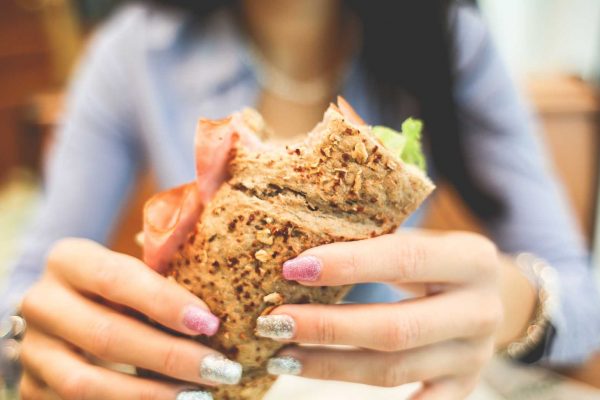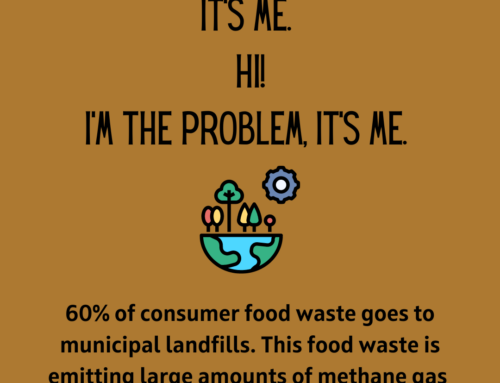This post contains affiliate Amazon links.
Your back to school routine may be anything but routine these days. In any case, everyone still needs to eat lunch.
If you are schooling and working from home, it’s still a good idea to prep a lunch in the morning. When you plan ahead, you can provide nutritious, balanced lunches for the whole family.
- Plan to pack a protein, 1-2 servings of grain, a fruit and/or vegetable
- Encourage your child or teen to buy calcium-rich milk with lunch everyday.
- A small salty or sweet treat is okay too.
Portions Matter
It’s a good idea to familiarize yourself with a serving size. For protein foods like meats or fish, 2-5 ounces is appropriate. For items like grains, it can vary. Generally, one serving is about 1 slice of bread, 6 crackers, or 1/2 cup rice or pasta. A serving of fruit or vegetable is equivalent to 1/2 cup. For a young child (preschool through grade 3), 2-3 baby carrots may be plenty, whereas a teenager may eat a large tossed salad.
Treats can fit into the meal too, as long as portions aren’t overboard. In fact, depriving kids of these kinds of treats can make them feel like they’re missing something and possibly even result in overeating when they do get the chance to have them. Providing a 1-ounce bag of chips or two cookies in the lunchbox along with more nutritious foods, helps teach children about portion control and balance.
Everyone Can Pitch In
Be sure to involve your kids in some of the choices and packing – you don’t have to do all the work. Even young children can begin to help pack lunches or get items ready the night before. Have your child go grocery shopping with you, or create your next grocery list.
If you have some staples stocked, you can allow the children to make choices. Even if you are schooling from home, it’s a good idea to pack the right foods in the right portions so you can assure a balanced lunch when everyone’s hungry. Try these simple lunchbox ideas:
- Lean meats (baked ham, roast turkey, pouch tuna fish). Cheese or cottage cheese, tofu or beans also provide protein.
- Peanut Butter. It’s a simple, staple protein source that requires no refrigeration. Go for natural types or brands with limited ingredients. Peanuts should be the first ingredient.
- Whole wheat bread and wraps, whole wheat crackers, small whole-wheat tortillas or pitas. Add a spread of cream cheese or hummus to a wrap (I love Flat-outs), a slice of ham or turkey, a lettuce leaf or baby spinach leaves, and roll up. You can also refrigerate ahead, and then slice into pinwheels in the morning. If heading out the door, be sure to pack with an ice pack. If your child is going through the “I don’t like crust” phase, don’t fuss over it, just trim it off. They will eat more of the sandwich if you trim ahead, than if they eat around the crust.
- Cheese chunks. Cube cheese and place in a reusable container or bento box. Pack with apple slices or grapes and whole grain crackers.
- Fresh or packaged fruit. Large bags of apples are usually more economical. Look for smaller apples to avoid waste. Cut apple using an apple slicer, then wrap a rubber band around it to avoid browning. Grapes and berries travel well in small plastic containers too. Slice oranges into 4 wedges for quick and easy eating. Flavored or cinnamon applesauce has more added sugars, so choose those once in a while, and choose unsweetened applesauce more frequently.
- Veggies such as baby carrots, cucumber slices, bell pepper slices, celery sticks, all pack well. Use a small container to add a veggie dip. Use vegetables like baby spinach leaves or chopped lettuce to add to wraps or sandwiches.
Save Money by Going Green
There are many tempting packaged items at the store to choose from, but these are not only more expensive, but also produce a lot of paper, plastic, and waste. Sure, sometimes you are time-stressed and want the convenience, but other times, consider your wallet and the environment and waste less by investing in a few reusable containers and flatware. There are a variety of reusable snack and sandwich bags available now. The reusable containers make lunch packing easy, and also prevent the food item from getting smashed or bruised.
- Nuts. Put a few tablespoons of nuts (about 20) into a small round container or zippered snack bag.
- Using leftovers. A hard cooked egg or a leftover chicken drumstick is often welcome in a school lunch box. Some lunchrooms may allow students to microwave, if not, consider investing in a hot thermos.
- Pack fruit/veggies in small container. I’ve been in the lunchroom – many parents pack HUGE portions of healthy foods thinking they are doing a good thing for their kids. An elementary student only needs to eat 4-5 baby carrots or 5-6 strawberries at lunchtime. Believe me, the rest goes into the garbage cans. So pack smaller portions into small container – 12 grapes, 5 strawberries, one sliced kiwifruit, 4 cucumber slices, half an apple, or a small apple sliced.
- Make your own yogurt parfait kits. Instead of buying the pre-made parfait or yogurt topped with candy, buy large containers of low fat vanilla yogurt. Scoop some out into your reusable container, and pack granola, sliced fruit or fresh blueberries into small snack bags for your child to assemble at lunchtime.
- Make a homemade lunch kit. Combine a sandwich, fruit and cookie, instead of relying on packaged lunch kits (there’s not only less waste, but a lot less sodium). Shop for a reusable lunch kit container.
- Try a Bento Box. These neat contraptions are partitioned containers that are reusable and pack each food group neatly into its spot.
Small Treats are Okay
Sugar can sneak into our diets at times in unknown ways, but small amounts can make some foods more enjoyable. Sure, sugar has no health benefit, is nutrient-free and an unnecessary part of your diet, but it tastes good and can make many different types of foods enjoyable. Balance, portions and moderation is important – choose whole foods first (protein, grain, fruit, veggie, milk) then allow the small treat. Again, when you pack a treat into your child’s lunchbox, keep small portions in mind. Two cookies are enough, one cupcake, a one-ounce bag of chips or snack crackers, or a bite-size piece of candy will add some fun to your child’s lunchbox, but keep calories, sugar and sodium in check.






Loved the recipe! Tastes so flavourful despite so little going into it! Thanks a ton:)